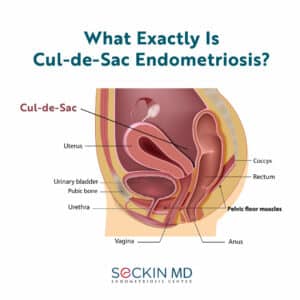What Exactly Is Cul-de-Sac Endometriosis?

The cul-de-sac, also known as the pouch of Douglas or the rectovaginal septum, is a space between the uterus and the rectum. The cul-de-sac region is the lowest region of the abdominal cavity. It is often prone to fluid collection during ovulation and menstruation. Cul-de-sac endometriosis is difficult to diagnose.
Can endometriosis affect the cul-de-sac?
Endometriosis and related adhesions can affect the cul-de-sac apart from other regions in the pelvic cavity. The posterior cul-de-sac, which is the space between the uterus and the rectum, is among the most common sites of deep-infiltrating endometriosis (DIE) and bowel endometriosis. The anterior cul-de-sac, which is the space between the bladder and the uterus, is relatively less affected.
Why is understanding cul-de-sac endometriosis important?
Cul-de-sac endometriosis causes the cardinal symptoms associated with the disease. It is characterized particularly by pelvic tenderness, pain during bowel movements, pain during intercourse, and severe dysmenorrhea. However, the disease is also associated with atypical symptoms. These include intermittent or constant pain that is independent of the monthly cycle. This can lead to delayed diagnosis up to several years.
It is important to first define the extent of cul-de-sac endometriosis. Has the disease infiltrated the cul-de-sac completely? Complete involvement of the cul-de-sac occurs in DIE and in the most severe stages. This happens when the planes between the posterior uterus and the rectum are destroyed. Early diagnosis and treatment are crucial to preventing an ” obliterated” cul-de-sac.
Why is diagnosing cul-de-sac endometriosis difficult?
Diagnostic delay begins with the non-specific nature of symptoms. Symptoms that resemble those of appendicitis, kidney stones, irritable bowel disease, and blood in stools are non-specific to cul-de-sac endometriosis alone. This means most patients will undergo a number of tests before suspecting endometriosis.
Additionally, we know that the stage/ extent of endometriosis and a patient’s symptoms do not necessarily correlate.
Healthcare professionals are often unfamiliar with how endometriosis lesions in the cul-de-sac region appear during transvaginal ultrasound (TVUS) or on physical exam. It may be necessary to complement routine imaging with other techniques such as MRI, CT, or colonoscopy for further confirmation.
How do we treat it?
Endometriosis lesions can distort cul-de-sac anatomy. Therefore, a surgeon experienced in the anatomy of the region and in laparoscopic deep excision is necessary for removing all lesions in this region.
Upon confirmation of the involvement of the cul-de-sac via imaging techniques or a rectovaginal examination, laparoscopic deep excision can help in isolating all identified lesions. This technique provides easy access to the rectovaginal area for the surgeon while also leading to shorter recovery times.
Doctors at the Seckin Endometriosis Center use a patented Aqua Blue Contrast (ABC)TM technique that improves visibility. We prefer a cold excision technique that minimizes damage to surrounding healthy tissue, unlike heat or laser fulguration. Depending on the severity of the disease, a multi-disciplinary team may be necessary involving a colorectal surgeon.
Have you received a diagnosis of cul-de-sac endometriosis? Please share your story by leaving a comment on our post on Facebook or Instagram if you wish.
Get a Second Opinion
Our endometriosis specialists are dedicated to providing patients with expert care. Whether you have been diagnosed or are looking to find a doctor, they are ready to help.Our office is located on 872 Fifth Avenue New York, NY 10065.
You may call us at (646) 960-3080 or have your case reviewed by clicking here.